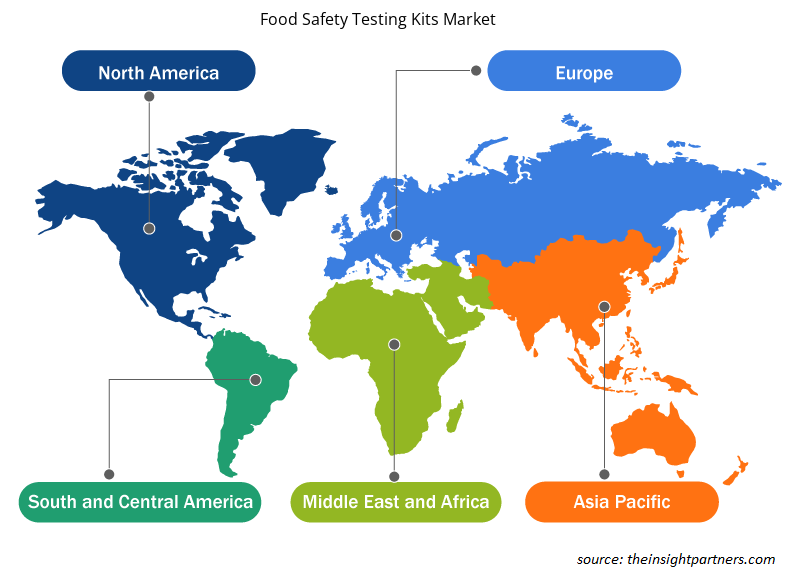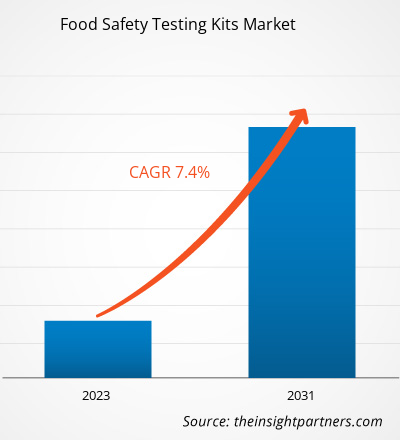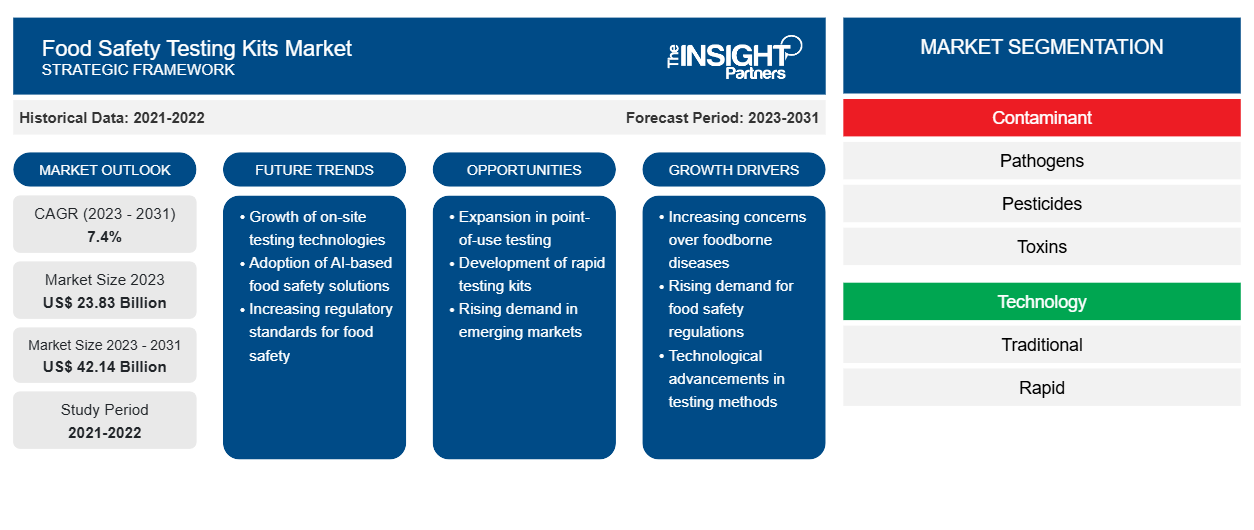Der Markt für Testkits zur Lebensmittelsicherheit wird voraussichtlich von 23,83 Milliarden US-Dollar im Jahr 2023 auf 42,14 Milliarden US-Dollar im Jahr 2031 anwachsen. Der Markt wird voraussichtlich zwischen 2023 und 2031 eine durchschnittliche jährliche Wachstumsrate von 7,4 % verzeichnen. Die stark wachsende Lebensmittel- und Getränkeindustrie wird voraussichtlich weiterhin ein wichtiger Markttrend für Testkits zur Lebensmittelsicherheit bleiben.CAGR of 7.4% in 2023–2031. Significantly growing food & beverages industry is likely to remain key food safety testing kits market trends.
Marktanalyse für Testkits zur Lebensmittelsicherheit
Alle Antibiotika und andere antimikrobielle Mittel werden zur Behandlung von Infektionen eingesetzt, die durch Bakterien verursacht werden. Der Missbrauch und die Überverwendung von antimikrobiellen Mitteln in der Human- und Veterinärmedizin steht im Zusammenhang mit der Entstehung resistenter Bakterien, die die Behandlung von Menschen und Tieren wirkungslos machen. Antimikrobielle Medikamente gelten als eine der größten Bedrohungen für die moderne Medizin. Daher ist es äußerst wichtig geworden, die Verunreinigungen im Voraus zu erkennen und zu verhindern, dass sie in die Nahrungskette gelangen. Daher hat die Bedeutung von Testkits zur Lebensmittelsicherheit weltweit mengenmäßig zugenommen. Darüber hinaus hat der Rückgang der Nachfrage nach Ölsaaten und Getreide im Lebensmittelservice den Umsatz im Jahr 2020 beeinträchtigt. Die Wiedereröffnung globaler Foodservice-Plattformen und höhere Verkaufspreise dürften das Marktwachstum für Testkits zur Lebensmittelsicherheit im Prognosezeitraum ankurbeln.antimicrobials are used to treat infections caused by bacteria. The misuse and overuse of antimicrobials in human and veterinary medicine has been linked to the emergence of resistant bacteria rendering the treatment of humans and animals ineffective. Antimicrobial medicine is identified as one of the biggest threats to modern medicine. Therefore, it has become extremely important to detect the contaminants beforehand and prevent them from entering the food chain. Thus, the importance of food safety testing kits has been increasing globally in terms of volume. Moreover, the decline in food service demand for oilseeds and grains harmed sales during 2020, the reopening of global foodservice platforms and higher selling prices is expected to boost the food safety testing kits market growth over the forecast period.
Marktübersicht für Testkits zur Lebensmittelsicherheit
Bei der Lebensmittelsicherheitsprüfung handelt es sich um eine wissenschaftliche Analyse eines Lebensmittelprodukts und seines Inhalts, um Informationen über verschiedene Eigenschaften wie physikochemischen Eigenschaften, Zusammensetzung und Struktur zu erhalten. Die Informationen werden verwendet, um die Sicherheit des Produkts für den Verzehr zu bestimmen. Die steigende Prävalenz von durch Lebensmittel verursachten Krankheiten erfordert Lebensmittelsicherheitsprüfungen für alle Lebensmittel und Getränke, um Gesundheitsrisiken vorzubeugen, was das Wachstum des Marktes für Lebensmittelsicherheitstestkits fördert.
Passen Sie diesen Bericht Ihren Anforderungen an
Sie erhalten kostenlos individuelle Anpassungen an jedem Bericht, einschließlich Teilen dieses Berichts oder einer Analyse auf Länderebene, eines Excel-Datenpakets sowie tolle Angebote und Rabatte für Start-ups und Universitäten.
-
Holen Sie sich die wichtigsten Markttrends aus diesem Bericht.Dieses KOSTENLOSE Beispiel umfasst eine Datenanalyse von Markttrends bis hin zu Schätzungen und Prognosen.
Markttreiber und Chancen für Testkits zur Lebensmittelsicherheit
Aufstieg der globalen Lebensmittel- und Getränkeindustrie begünstigt den Markt
Die Lebensmittel- und Getränkeindustrie umfasst alle Unternehmen, die mit dem Vertrieb, der Verpackung und der Verarbeitung von Lebensmitteln befasst sind. Dazu gehören alkoholfreie Getränke, alkoholische Getränke, verpackte Lebensmittel und frische Lebensmittel. Fast alle für den menschlichen Verzehr bestimmten Produkte, mit Ausnahme von pharmazeutischen Produkten, sind in dieser Branche enthalten. Die Lebensmittel- und Getränkeindustrie konzentriert sich zunehmend auf mechanische Manipulation und Technologie, um Produkte mit höherer Wertschöpfung zu schaffen. Darüber hinaus steigt mit dem Bevölkerungswachstum und der wachsenden Mittelschicht in den Entwicklungsländern die Nachfrage nach einer Vielzahl von Lebensmitteln. Somit treibt die wachsende Lebensmittel- und Getränkeindustrie das Wachstum des Marktes für Testkits für Lebensmittelsicherheit voran.
Steigender Milchkonsum – eine Chance auf dem Markt für Testkits zur Lebensmittelsicherheit
Der Milchsektor ist einer der anfälligsten Sektoren für lebensmittelbedingte Krankheiten, da Milchprodukte eine Vielzahl von Mikroorganismen beherbergen. Da durch Pasteurisierung möglicherweise nicht alle Krankheitserreger in der Milch abgetötet werden, ist eine Prüfung der Milch zur Gewährleistung der Sicherheit unerlässlich. Milch ist außerdem eines der Produkte, das weltweit täglich in großen Mengen konsumiert wird. Der hohe Milchkonsum führt daher zu einer größeren Menge an Testkits für Lebensmittelsicherheit, was den Markt weiter ankurbelt.foodborne illnesses as dairy products harbor a variety of microorganisms. As pasteurization may not destroy all pathogens in milk, testing of milk becomes essential to ensure safety. Milk is also one of the products that is consumed daily in large quantities all over the world. Thus, the high milk consumption leads to a higher volume of food safety testing kits driving the market further.
Marktbericht zu Testkits für Lebensmittelsicherheit – Segmentierungsanalyse
Wichtige Segmente, die zur Ableitung der Marktanalyse für Testkits zur Lebensmittelsicherheit beigetragen haben, sind Verunreinigungen, Technologie und Lebensmittelart.
- Basierend auf Verunreinigungen ist der Markt für Testkits zur Lebensmittelsicherheit in Krankheitserreger, Pestizide, Toxine, GVO und andere unterteilt. Das Krankheitserregersegment ist weiter unterteilt in Salmonellen, E. coli, Listeria, Campylobacter, S. aureus und andere. Das Krankheitserregersegment hielt im Jahr 2023 einen größeren Marktanteil.
- Basierend auf der Technologie ist der Markt zweigeteilt: traditionell und schnell. Das schnelle Segment wird in PCR-basierte Tests, immunoassaybasierte Tests, LAMP und andere unterteilt.
- In Bezug auf die Anwendung ist der Markt in Fleisch-, Geflügel- und Meeresfrüchteprodukte, Milchprodukte, Getreide und Körner, verarbeitete Lebensmittel, Obst und Gemüse und andere unterteilt. Das Segment Fleisch-, Geflügel- und Meeresfrüchteprodukte dominierte den Markt im Jahr 2023.
Marktanteilsanalyse für Testkits zur Lebensmittelsicherheit nach geografischer Lage
Der geografische Umfang des Marktberichts zu Testkits für Lebensmittelsicherheit ist hauptsächlich in fünf Regionen unterteilt: Nordamerika, Asien-Pazifik, Europa, Naher Osten und Afrika sowie Südamerika/Süd- und Mittelamerika.
Der Markt für Testkits für Lebensmittelsicherheit in Nordamerika wächst derzeit stark. Der Markt für Testkits für Lebensmittelsicherheit befindet sich derzeit in der Wachstumsphase und verzeichnet ein exponentielles Wachstum. Nordamerika ist ein wichtiger Knotenpunkt für die Lebensmittelverarbeitung. Nach Angaben der US-amerikanischen Food and Drug Administration (FDA) waren im September 2022 in den USA 99.451 inländische Lebensmittelbetriebe registriert. Die Länder in Nordamerika haben strenge Regulierungsbehörden in Bezug auf die Lebensmittelsicherheit. Die hohe Menge an Lebensmittelverarbeitung in der Region dürfte sich positiv auf das Marktwachstum für Testkits für Lebensmittelsicherheit auswirken.
Regionale Einblicke in den Markt für Testkits zur Lebensmittelsicherheit
Die regionalen Trends und Faktoren, die den Markt für Testkits für Lebensmittelsicherheit während des gesamten Prognosezeitraums beeinflussen, wurden von den Analysten von Insight Partners ausführlich erläutert. In diesem Abschnitt werden auch die Marktsegmente und die Geografie von Testkits für Lebensmittelsicherheit in Nordamerika, Europa, im asiatisch-pazifischen Raum, im Nahen Osten und Afrika sowie in Süd- und Mittelamerika erörtert.

- Erhalten Sie regionale Daten zum Markt für Testkits zur Lebensmittelsicherheit
Umfang des Marktberichts zu Testkits für Lebensmittelsicherheit
| Berichtsattribut | Details |
|---|---|
| Marktgröße im Jahr 2023 | 23,83 Milliarden US-Dollar |
| Marktgröße bis 2031 | 42,14 Milliarden US-Dollar |
| Globale CAGR (2023 - 2031) | 7,4 % |
| Historische Daten | 2021-2022 |
| Prognosezeitraum | 2023–2031 |
| Abgedeckte Segmente |
Nach Schadstoff
|
| Abgedeckte Regionen und Länder |
Nordamerika
|
| Marktführer und wichtige Unternehmensprofile |
|
Dichte der Marktteilnehmer für Testkits zur Lebensmittelsicherheit: Die Auswirkungen auf die Geschäftsdynamik verstehen
Der Markt für Testkits zur Lebensmittelsicherheit wächst rasant, angetrieben durch die steigende Nachfrage der Endnutzer aufgrund von Faktoren wie sich entwickelnden Verbraucherpräferenzen, technologischen Fortschritten und einem größeren Bewusstsein für die Vorteile des Produkts. Mit steigender Nachfrage erweitern Unternehmen ihr Angebot, entwickeln Innovationen, um die Bedürfnisse der Verbraucher zu erfüllen, und nutzen neue Trends, was das Marktwachstum weiter ankurbelt.
Die Marktteilnehmerdichte bezieht sich auf die Verteilung der Firmen oder Unternehmen, die in einem bestimmten Markt oder einer bestimmten Branche tätig sind. Sie gibt an, wie viele Wettbewerber (Marktteilnehmer) in einem bestimmten Marktraum im Verhältnis zu seiner Größe oder seinem gesamten Marktwert präsent sind.
Die wichtigsten auf dem Markt für Testkits zur Lebensmittelsicherheit tätigen Unternehmen sind:
- SGS SA
- Eurofins Scientific
- Intertek Group Plc
- TÜV SÜD
- AES Laboratories Pvt. GmbH.
Haftungsausschluss : Die oben aufgeführten Unternehmen sind nicht in einer bestimmten Reihenfolge aufgeführt.

- Überblick über die wichtigsten Akteure auf dem Markt für Testkits zur Lebensmittelsicherheit
Marktnachrichten und aktuelle Entwicklungen zu Testkits für Lebensmittelsicherheit
Der Markt für Testkits zur Lebensmittelsicherheit wird durch die Erhebung qualitativer und quantitativer Daten nach Primär- und Sekundärforschung bewertet, die wichtige Unternehmensveröffentlichungen, Verbandsdaten und Datenbanken umfasst. Im Folgenden finden Sie eine Liste der Entwicklungen auf dem Markt für Innovationen, Geschäftserweiterungen und Strategien:
- Im Mai 2021 gab Eurofins Food and Water Testing UK & Ireland die Übernahme von Alliance Technical Laboratories (ATL) Ltd. bekannt. Die Übernahme wird das Angebot des Unternehmens an Testdienstleistungen für Lebensmittel, Wasser und Futtermittel im Südosten verbessern und ist Teil seiner geplanten strategischen Wachstumsagenda. (Quelle: Eurofins, Pressemitteilung)
- Im Juni 2021 gab SGS die Eröffnung seines neuen Lebensmittelprüflabors in Papua-Neuguinea bekannt. Das neue Labor bietet international anerkannte Qualitätsprüfungen für die Marktsegmente Lebensmittelherstellung, Gastronomie und Einzelhandel an. Die Einrichtung bietet eine breite Palette von Prüfdienstleistungen an, wie z. B. Indikatoren für Lebensmittelmikrobiologie, Krankheitserreger in der Lebensmittelmikrobiologie, Wassermikrobiologie und Wasserchemie. (Quelle: SGS, Newsletter)
Marktbericht zu Testkits für Lebensmittelsicherheit – Umfang und Ergebnisse
Der Bericht „Marktgröße und Prognose für Testkits zur Lebensmittelsicherheit (2021–2031)“ bietet eine detaillierte Analyse des Marktes, die die folgenden Bereiche abdeckt:
- Marktgröße und Prognose auf globaler, regionaler und Länderebene für alle wichtigen Marktsegmente, die im Rahmen des Projekts abgedeckt sind
- Marktdynamik wie Treiber, Beschränkungen und wichtige Chancen
- Wichtige Zukunftstrends
- Detaillierte PEST/Porters Five Forces- und SWOT-Analyse
- Globale und regionale Marktanalyse mit wichtigen Markttrends, wichtigen Akteuren, Vorschriften und aktuellen Marktentwicklungen
- Branchenlandschaft und Wettbewerbsanalyse, einschließlich Marktkonzentration, Heatmap-Analyse, prominenten Akteuren und aktuellen Entwicklungen
- Detaillierte Firmenprofile
- Historische Analyse (2 Jahre), Basisjahr, Prognose (7 Jahre) mit CAGR
- PEST- und SWOT-Analyse
- Marktgröße Wert/Volumen – Global, Regional, Land
- Branchen- und Wettbewerbslandschaft
- Excel-Datensatz
Aktuelle Berichte
Verwandte Berichte
Erfahrungsberichte
Grund zum Kauf
- Fundierte Entscheidungsfindung
- Marktdynamik verstehen
- Wettbewerbsanalyse
- Kundeneinblicke
- Marktprognosen
- Risikominimierung
- Strategische Planung
- Investitionsbegründung
- Identifizierung neuer Märkte
- Verbesserung von Marketingstrategien
- Steigerung der Betriebseffizienz
- Anpassung an regulatorische Trends























 Kostenlose Probe anfordern für - Markt für Testkits zur Lebensmittelsicherheit
Kostenlose Probe anfordern für - Markt für Testkits zur Lebensmittelsicherheit